
Warning, if you don't want any beta on either of these two routes,
leave this page now.
There are some short 30 second videos at the end
By 10am, Erin Shea, our guest climber, and I started up the trail. Of the three options, I have developed an appeal for the middle route up the talus field that dumps you very close to the start of the Wiessner's Dike. This being Erin's second time, we decided for the right route, which has less talus...In half an hour we were at the base of the climb, unfortunately a party was already ahead of us. We opted to wait.
The first pitch goes up the obvious dike to a nice double bolt anchor. I start out fine, I have done this route about 7 times, so it should be no problem. Sure I have not climbed in about 2 months, and I am "recovering" but still. Hmm, I stop, and notice that there is no pro for the next 10 feet, equally important, I have not placed anything in the last 20 or so. I do not feel as comfortable as I should. For about 10 seconds, I feel like I am sketched out... not good. Ok, cooly (just made up that word) I downclimb a bit and clip to a pin. Now I feel safer. I climb up, and find the easier way a bit on the right. It is all about balance. Cool the climb continues, and life goes on
Erin starts up the climb
Pitch 2 start is pretty cool, you go out on to the face on the right and climb over few flakes...
This is the classic pitch 5, a nice 5.5 face, with a little bit of jamming.
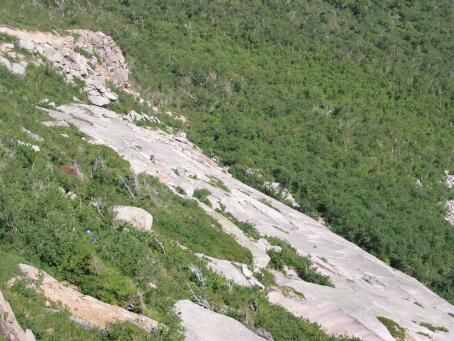
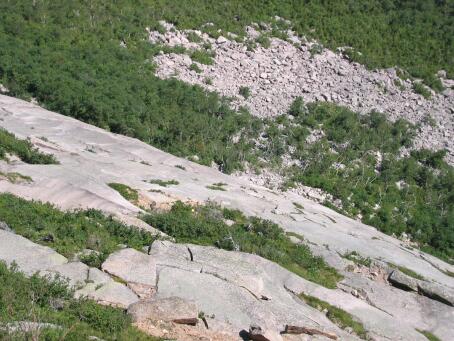
At some point I am going to stitch these pictures into a panorama.
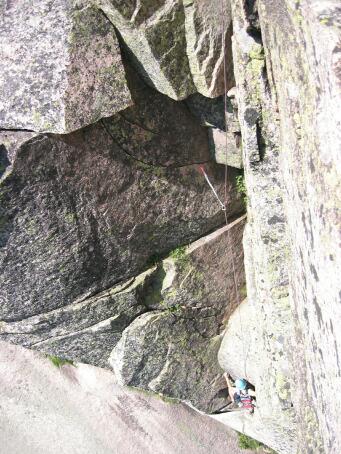
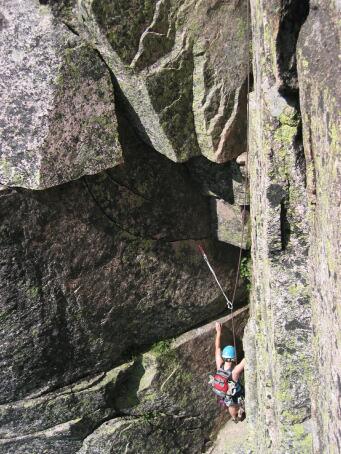
These previous pictures are the cool sequence of the Chimney of the last pitch. This pitch makes the whole climb worth while, it is so fun. Notice the high-angle camara-man (me). The rigging takes a lot of work, but I take my job very seriously... If you need a photographer to capture those cool climbing moments, I am your man.
Erin is psyched, this would be her first time leading, and leading multi-pitch. I know that she is ready, you just need to find the right route (something well within your range) and the right partner (someone who does not make you nervous, encourages you and who you feel comfortable saying at anytime: "hey this is not happening for me, could you lead this or bail on the route." This is important because if you get hurt on your first lead you can get climber's block and not be happy).
She starts off, places two good pieces, and then sees the beauty of being the leader... this thing called route-finding... she bears a little too much to the right, until she realizes: "hmm, not much gear here", I reply "ahh, the route is more to the left." She gets back on track and cruises up to the first anchor. To make it more exciting, it is somewhat crowded by our friends...she sets up a nice beefy three point anchor.
Pitch 2 is somewhat scary because you get on top of this huge overlap and the traversing starts. The right starts by going a little to the right, where there is a hidden vertical crack. Erin for some reason really likes my small gear, she places either a blue alien or something... good that she somehow trusts these small pieces unlike someone I know but I wont mention any names (Robert did you ever get my postcard?). After you get on top of the first overlap (from the right), you start the big traverse left, and up onto another overlap with a huge wide crack. As a general note, this route is somewhat hard to protect the second well. It is doable, but takes some creativity.
We share the belay with our front-party. One of them turns out to be also from MIT, and his follower is going to Northeastern -- it is his first time on a rock multipitch, but he is having a blast (except for the tiny shoes his friend lent him).
The next two pitches (or 2.5?) get you to lunch ledge. Here Erin learns about some truth of climbing, sometimes you may have to run it out a little, it all comes down to your comfort level. At one point she is trying to find some protection, looking very keenly at my very small pieces... after few minutes, I ask her "nothing yet? there seems to be some good stuff just few feet higher, how do you feel about the terrain you are on?," she confidently replies "it is easy", in few seconds she climbs few feet and places good gear.
Erin leads this 5.5 pitch without a problem, and for me I score a shiny new nut that was just sitting on a crack. I have absolutely no clue how it got there, since if you bailed on it you would have left a biner; if someone cleaned that biner, they would have cleaned the nut. My best guess, is that a follower cleaned the draw from it, and somehow got distracted and forgot about the nut.... who knows...
Kevin Eggan leading the nice face pitch below us. At lunch ledge, our friends let us pass (also want to get the beta of where the route goes, since it is their first time on it... I do that all the time), they are chilling at the best spot of them all, lunch ledge.
There are three ways to protect the famous (or infamous) Archival Flake (or Hump Flake) on the last pitch of this climb. Option number one, clip the pin that is right below and left of the flake: disadvantage major rope drag, unless you put like two double length runners on it. Option two as seen in the above picture, is to place a cam 10 feet below the flake; with an attentive belayer, it is possible to pull the rope, such that if the leader falls from the flake, he or she will not roll of the lip. Option number 3, which I heard from someone on the cliff, although not verified it myself, is to place a number 5 camelot (yes the big green puppy weighting in at 544 grams) on the flake.
Here is a sequence of pictures of Erin working on the flake. This hand traversal for me is the easiest way to do it; once I get high enough I throw my left left over the flake, locking myself with my calf. The other possibility is to ride it with your left leg (assuming is the right size leg) on the offwidth crack.
Kevin completing the last pitch.
The picture of wisdom and safety... another complete day of safe and
fun climbing...
Videos
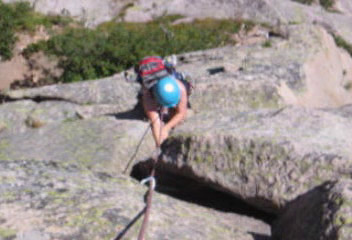 Handjam MPEG (5MB)
Handjam MPEG (5MB)
 Working
on the Flake (bottom view) MPEG (5MB)
Working
on the Flake (bottom view) MPEG (5MB)
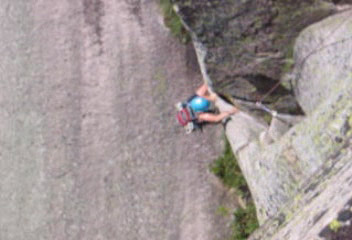 Working
on the Flake (top view) the MPEG (5MB)
Working
on the Flake (top view) the MPEG (5MB)